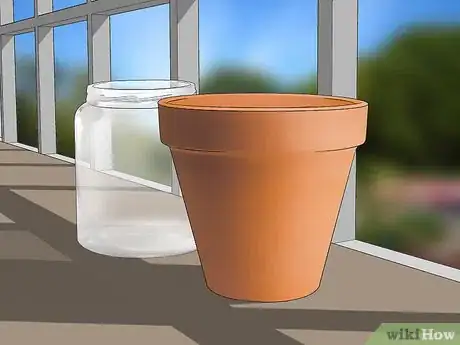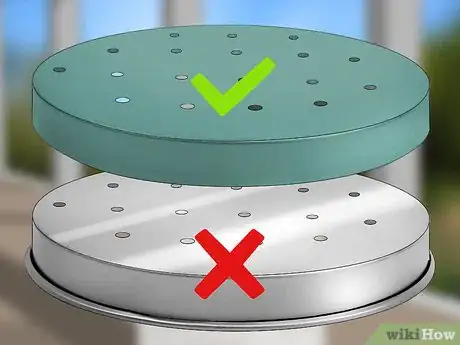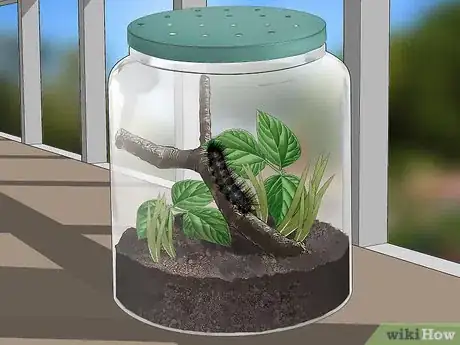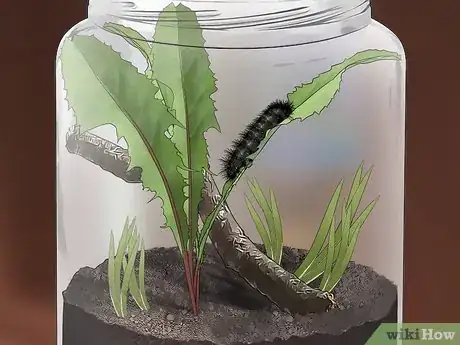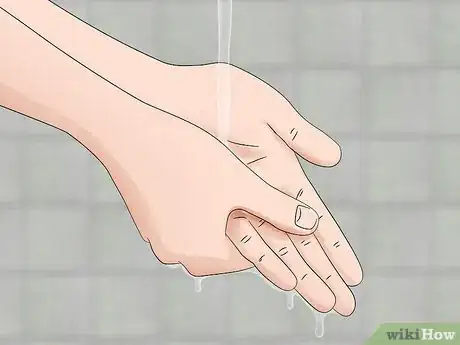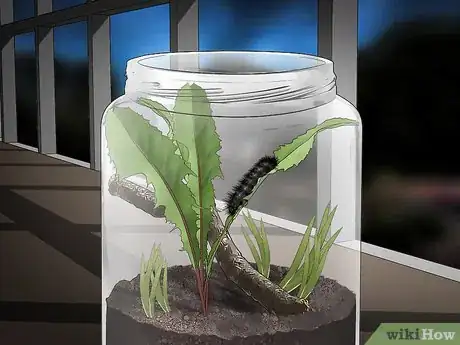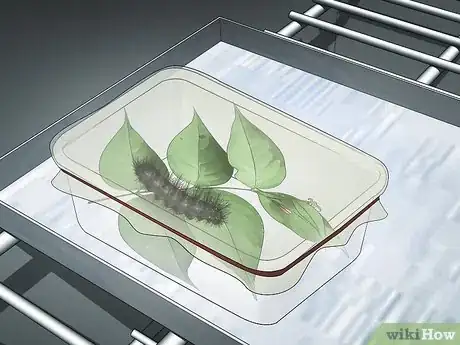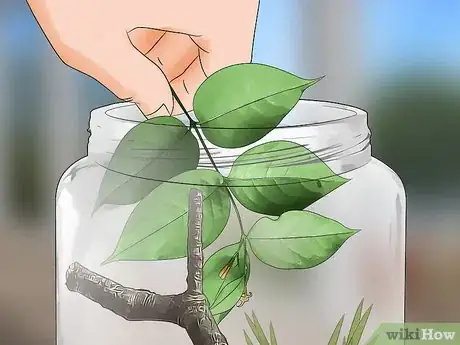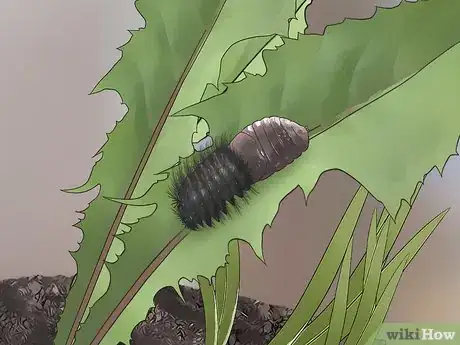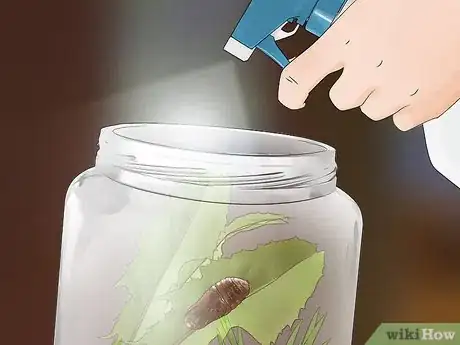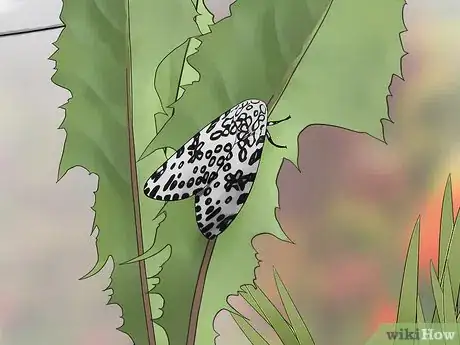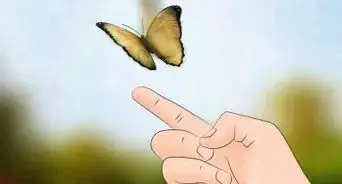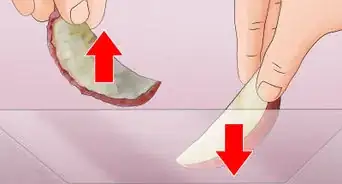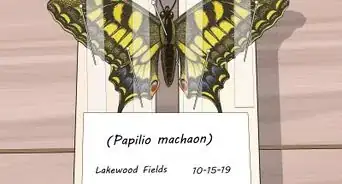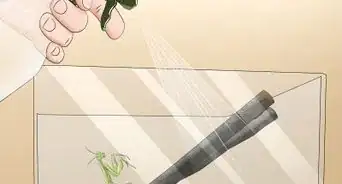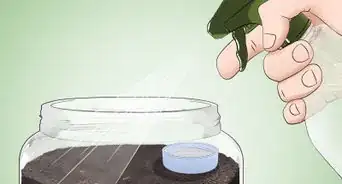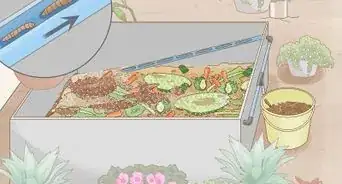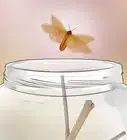This article was co-authored by wikiHow staff writer, Danielle Blinka, MA, MPA. Danielle Blinka is a Writer, Editor, Podcaster, Improv Performer, and Artist currently living in Houston, TX. She also has experience teaching English and writing to others. Danielle holds a Bachelor of Arts in English, Bachelor of Arts in Political Science, Master of Arts in English with a concentration in writing, and Master of Public Administration from Lamar University.
wikiHow marks an article as reader-approved once it receives enough positive feedback. This article received 14 testimonials and 87% of readers who voted found it helpful, earning it our reader-approved status.
This article has been viewed 214,030 times.
Learn more...
A giant leopard moth caterpillar is a fuzzy black caterpillar with orange or red stripes. While their bristles make the caterpillars look dangerous, they’re actually nonpoisonous and totally harmless. Caterpillars are a fun and unique pet and are perfect for children. With proper care, you can observe the life cycle and metamorphosis of your caterpillar into an adult leopard moth.
Steps
Making a Home for Your Caterpillar
-
1Find a large jar or flower pot. Nearly any container can be converted into a great caterpillar home as long as you are able to secure the caterpillar and provide it air holes. Since caterpillars can crawl up the sides, it’s important to have a cover for its home. Otherwise, it’ll crawl away.[1]
- If you have an aquarium or terrarium that allows air to flow through a lid made of screen netting, then you can use it instead of a jar. Check to make sure that the entire aquarium or terrarium is secure so that your caterpillar won’t escape.
-
2Create a breathable lid. Your caterpillar needs to breathe, so use a porous material like cheesecloth as a lid. Make sure that your cheesecloth doesn’t have holes that are big enough for the caterpillar to crawl through. You can secure the cheesecloth to your jar or pot with a large rubberband.[2]
- If you don’t have cheesecloth, you can try using plastic wrap with plenty of holes poked in it.
- Don’t use a metal jar lid because it can harm the caterpillar.
Advertisement -
3Put a 2-3 inch layer of dirt into your jar or pot. You can use dirt from your yard or generic potting soil. If you find the caterpillar in nature, collect dirt from the area the caterpillar is living.[3]
- Don’t take dirt from protected land, such as natural parks.
-
4Add grass, twigs, and leaves. Make your caterpillar comfortable by incorporating bits of its natural habitat. Your caterpillar will appreciate having places to crawl and hide.[4]
- Collect grass, twigs, and leaves from where you found the caterpillar.
- Do NOT put water into your caterpillar’s home because it will drown.
-
5Change out the leaves regularly. You need to change out your caterpillar’s leaves daily or at least every other day because the leaves will decay.
- If your caterpillar is on the old leaves, put in the new leaves and wait for it to crawl onto the new leaves on its own. Once it’s crawled over to the new leaves, you can remove the old ones.[5]
-
6Clean your caterpillar’s home. Caterpillars produce a lot of waste called frass, so you need to clean its home at least once a day to prevent mold or harm to your caterpillar.[6]
- Use a paper towel to wipe the frass from the cage.
-
7Place your caterpillar’s home outside. If you want to follow your caterpillar’s natural life cycle, the place it on a porch, balcony, or in a garden if you have one. Note that placing a glass jar in full sun on a warm day for even a few minutes can cook your caterpillar, so choose your outdoor location carefully. [7]
- Keep your caterpillar warm. The caterpillar will hibernate during the winter, so a cold caterpillar will not be as active.
- If you’re keeping it inside your house, consider putting it on a windowsill.
Feeding Your Caterpillar
-
1Check your yard for caterpillar favorites. If you found your caterpillar outside, start looking there. Caterpillars have a preferred diet, and they won’t switch food sources just because that’s what you give them. If you want your caterpillar to thrive, then you need to find the right plants.[8]
- Giant leopard moth caterpillars enjoy munching leafy plants like dandelions, violets, honeysuckle, citrus plants, magnolias, lilacs, and broadleaf plantains.[9]
- If you don’t find the plants in nature, you can buy a small potted plant. Dandelions, violets, and lilacs should be available in pots from your local garden store.
-
2Check carefully for spiders and other insects. Spiders and other insects can prey upon your caterpillar, so make sure that you don’t accidentally put a predator into your new pet’s home. You may come back to find your caterpillar has been eaten.[10]
-
3Place leaves from the plants inside your caterpillar’s home. At first, monitor your caterpillar to make sure that you are feeding it enough leaves. Caterpillars spend most of their time eating, so make sure that you meet your pet’s needs.[11]
- Feed your caterpillar daily.
- If you accidentally pull off more leaves than you need, you can keep them fresh by putting them in water and placing the container in the fridge.
- Remember not to put containers of water in your caterpillar’s home because it will drown.
-
4Add a host plant. If you have enough room in your caterpillar’s home, you can add a live plant for the caterpillar to eat. This is only possible for smaller plants, so look for one that will grow in a small pot, like a dandelion.[12]
Enjoying Your Caterpillar
-
1Wash your hands before you touch it. Caterpillars can pick up germs from your hands, so make sure that you are clean before you handle it.[13]
-
2Check on it at night. Giant leopard moth caterpillars are nocturnal, so your caterpillar will be most active at night. You can look for movement during the day, but don’t try to wake up the caterpillar if it’s sleeping.[14]
-
3Don’t pull your caterpillar off of a surface. Caterpillars will hold onto what they’re crawling on, so don’t try to remove your crawling critter. It will hold onto the surface and may be hurt.[15]
Helping Your Caterpillar Transform Into a Moth
-
1Allow your caterpillar to hibernate. In the wild, giant leopard moth caterpillars hibernate all winter as part of their life cycle. Caterpillars can hibernate outside in their containers all winter, or you can put it into the refrigerator. Don’t freeze your caterpillar.[16]
- Your caterpillar will not eat while it’s hibernating, but it may be lightly active on warmer days. When it’s mildly active, it might eat available food.
-
2Add more food to your caterpillar’s diet. When your caterpillar wakes up in the spring, it’ll be ready to fatten up in preparation for its metamorphosis into a moth, which will take place later in the spring. Make sure that you provide your caterpillar enough food for it to get ready to turn into a pupa, which is its cocoon-phase.[17]
-
3Wait for your caterpillar to shed its exoskeleton. Your caterpillar’s fuzzy skin will slide off once it has fattened up, leaving a smooth black oval called a pupa. This is it’s cocoon phase. You can expect it to shed its exoskeleton during spring.[18]
-
4Check the pupa daily. Since you can’t pinpoint the actual date of your moth’s emergence, keep track of its progress each day. While your pupa does not need food, you may want to mist the caterpillar’s home daily to keep it humid. Simply spray a light spritz of water into the container.[19]
- While their actual time in the pupa can vary, giant leopard moth caterpillars only take a few weeks to metamorphose into a moth.
-
5Watch your giant leopard moth emerge. You can choose to keep your moth or set it free.[20]
Community Q&A
-
QuestionI'm in Ohio and just found a large caterpillar. It is January. Are they active in winter and when will it pupate? Also it may rear its head up when I put a finger down. Sometimes it turns upside Down?
 Community AnswerUsually they are not active during the winter, but sometimes they are on mild days. It's also possible that the caterpillar hatched later than usual. It should pupate in the spring. Caterpillars are very flexible, so it's normal for them to move around a lot.
Community AnswerUsually they are not active during the winter, but sometimes they are on mild days. It's also possible that the caterpillar hatched later than usual. It should pupate in the spring. Caterpillars are very flexible, so it's normal for them to move around a lot. -
QuestionWhen will my caterpillar build a cocoon?
 Community AnswerWhen it is ready to pupate, it will stop eating for a few days and become sluggish.
Community AnswerWhen it is ready to pupate, it will stop eating for a few days and become sluggish. -
QuestionWhat if I find one in winter and can't find any leaves for it? Should I feed it domesticated flowers' leaves?
 Community AnswerYou can feed it domesticated leaves as long as they are what the caterpillar likes to eat, such as dandelion, lilacs, violets, citrus fruits, and honeysuckle.
Community AnswerYou can feed it domesticated leaves as long as they are what the caterpillar likes to eat, such as dandelion, lilacs, violets, citrus fruits, and honeysuckle.
Warnings
- They may emit a stinky odor if they’re scared.⧼thumbs_response⧽
- Don’t put water in your caterpillar’s home because they will drown. Caterpillars get water from the plants they eat.⧼thumbs_response⧽
Things You'll Need
- Jar, pot, or aquarium
- Giant leopard moth caterpillar
- Twig(s)
- Grass
- Dirt
- Different types of leaves
References
- ↑ http://www.animalspot.net/giant-leopard-moth.html
- ↑ http://www.butterflyschool.org/teacher/raising.html
- ↑ http://www.animalspot.net/giant-leopard-moth.html
- ↑ http://www.animalspot.net/giant-leopard-moth.html
- ↑ http://www.butterflyschool.org/teacher/raising.html
- ↑ http://www.butterflyschool.org/teacher/raising.html
- ↑ http://www.animalspot.net/giant-leopard-moth.html
- ↑ http://www.animalspot.net/giant-leopard-moth.html
- ↑ http://www.animalspot.net/giant-leopard-moth.html
- ↑ http://www.butterflyschool.org/teacher/raising.html
- ↑ http://www.butterflyschool.org/teacher/raising.html
- ↑ http://www.butterflyschool.org/teacher/raising.html
- ↑ http://www.butterflyschool.org/teacher/raising.html
- ↑ http://www.animalspot.net/giant-leopard-moth.html
- ↑ http://www.butterflyschool.org/teacher/raising.html
- ↑ http://www.animalspot.net/giant-leopard-moth.html
- ↑ http://www.hiltonpond.org/thisweek020608.html
- ↑ http://www.hiltonpond.org/thisweek020608.html
- ↑ http://www.butterflyschool.org/teacher/raising.html
- ↑ http://www.hiltonpond.org/thisweek020608.html
About This Article
To care for a giant leopard moth caterpillar, start by finding a large container that has a secure cover that will also allow air flow, such as a cheesecloth secured with a rubber band or a piece of plastic wrap with small holes poked into it. Next, put 2-3 inches of dirt into your jar or pot, and add some grass and twigs. Then, place your caterpillar’s home outside or on a windowsill to give it lots of natural light and air. In order to feed your caterpillar, give it leafy plants like dandelions, violets, honeysuckle, and lilacs daily. To learn how to help your caterpillar transform into a moth, keep reading!
